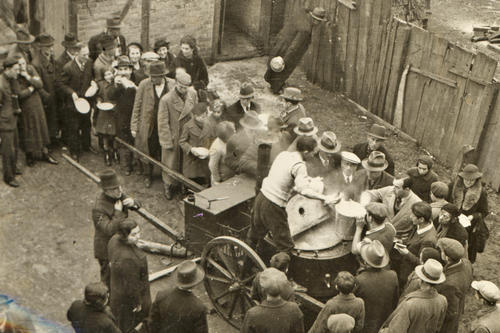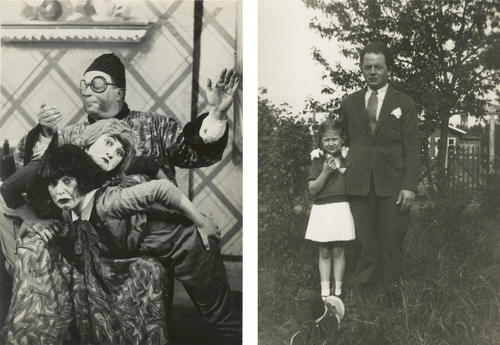An Exhibition to Keep Memories Alive
Students and scholars from Freie Universität have studied the fates of Polish Jewish families from Berlin who were arrested and deported by the Nazis in 1938.
Apr 23, 2018
A mobile soup kitchen in Zbąszyń in 1938: Calls went out in Polish Jewish and Yiddish newspapers, asking the community to donate food, physical objects, and money for the Jews who had been deported.
Image Credit: Yad Vashem
Martin Merory (left) in “Kasperle's Journey to Wonderland” around 1930 in the Renaissance Theater in Charlottenburg. Right: His brother Walter Merory with daughter Ingeburg.
Image Credit: Archiv der Akademie der Künste Berlin (links); Privat (rechts)
In October 1938, more than 16,000 Jews who were citizens of Poland were arrested in Nazi Germany and deported to the Polish border. Many of them had been born in Germany or had lived there for decades.
They were, as we would say today, Germans from immigrant backgrounds. And then one day, the police showed up on their front doorstep. The German government’s plan was to deport these people to Poland. The Nazis called their inhuman act the “Polenaktion” – the Poland campaign.
Further Research Needed on This Chapter of History
The Polish government had revoked most of the deportees’ Polish citizenship beforehand. After they arrived in Poland, they turned to Jewish aid organizations for help. Several thousand people had to stay in a refugee camp on the border between Germany and Poland until the summer of 1939. Many of them were later murdered by the Nazis.
“The Polenaktion marked the start of the radicalization in the persecution of Jews by the Nazis,” says Gertrud Pickhan. “However, further research is needed on the Polenaktion as a separate chapter of history,” she explains. Pickhan is a professor of history at the Institute for East European Studies at Freie Universität Berlin. Together with historian Alina Bothe, who is currently writing a postdoctoral thesis on this subject, and students from Freie Universität, Pickhan has now explored the history of the Jewish residents of Berlin who were deported in 1938.
Pickhan and Bothe have supervised four seminars in all since 2014 where students independently investigated the family histories and fates of those affected. The extensive, time-consuming project received the 2015-2016 USC Shoah Foundation Teaching Fellowship granted by the USC Shoah Foundation, which was founded in the U.S. by Steven Spielberg and collects the stories of Holocaust survivors on video worldwide to preserve them for posterity.
Today, the Visual History Archive makes its home at the University of Southern California in Los Angeles. Freie Universität Berlin is one of 80 institutions worldwide that cooperate with the Shoah Foundation. Students, instructors, researchers, and others who are interested in exploring the archive have had direct access via the Center for Digital Systems of Freie Universität since 2006.
The results of the research done on the Polenaktion will be shown at the Centrum Judaicum starting on July 8, in an exhibit curated by Bothe. The project was headed by Pickhan and Christine Fischer-Defoy of nonprofit organization Aktives Museum Faschismus und Widerstand in Berlin, and Kaspar Nürnberg of the Aktives Museum was responsible for coordination. Original documents such as photos, postcards, and files are used to reconstruct the detailed history of six families from Berlin who were affected by the deportation. “We want to wrest their lives from oblivion,” Bothe says.
Many of the students have been involved with the project for several semesters. Large parts of their master’s degree programs have been shaped by the project. “You don’t often get a chance to work this extensively on one subject during your studies,” says Christine Meibeck, a student. “We had a chance to do real research,” she adds.
Meibeck and fellow student Lara Büchel reconstructed the history of the Merory family, a family of artists from Berlin, many of whom were murdered by the Nazis. The duo’s research included the careers of Ella and Martin Merory, a married couple who were both actors. Martin Merory was a member of the ensemble at the Zweite Piscator-Bühne at the Theater am Nollendorfplatz in the 1920s. This particular theater was the heart of the artistic avant-garde at the time – Bertolt Brecht was among those who worked there. Merory and his brothers were deported in October 1938. His fate is still unknown to this day.
Much of the material the students reviewed had been entirely unknown until then. “The items on display in the exhibit are the latest historical findings. They have not yet been published anywhere,” Bothe says. That applies to the sequence of the deportation, along with the specific life histories of those deported. The sources used for the biographies were compiled by the students from various archives.
One of the main sources was the Entschädigungsbehörde des Landes Berlin, the state-level authority responsible for issues of compensation and reparations. Victims of Nazi persecution were able to turn to this office after the war for financial compensation as part of the new German government’s restitution and reparation policies. “The compensation policies weren’t exactly a glorious chapter in the history of the Federal Republic of Germany,” Pickhan says. “The monetary sums were small, and the victims were required to describe and prove every detail of their persecution in meticulous detail to get compensation.”
Anne Meissner, another student, used these files to reconstruct the history of the Eilberg family. Bernhard Eilberg, a trained textile merchant, was born in Berlin in 1911. He was arrested by the Gestapo at his apartment on Cuvrystrasse, in Kreuzberg, in October 1938 and ultimately deported to Poland from the Treptow train station. He spent five and a half years at various work camps and concentration camps before finally being liberated at the end of the war. He returned to Germany afterward and died in a rest home in Düsseldorf in 1992.
“Eilberg was shot in the concentration camp and suffered the aftereffects for the rest of his life,” Meissner says. “Every year, he had to prove his adverse health consequences to the compensation authorities again in order to get funding for a stay at a health resort.” Reading the files on the compensation process causes one to feel a close connection with people, she explains. This makes this kind of research a tricky balancing act between scholarly interest and the desire to safeguard people’s privacy.
“All of us have developed a kind of personal relationship to the families whose histories we studied over the past few years,” Meibeck says. “That has also made it a highly emotional project for us.” The research will also leave a lasting mark beyond the exhibition. In memory of the victims, the students have requested the placement of 30 cobblestone-sized commemorative plaques. The first few are scheduled for placement soon.
In the course of the exhibit and for a ceremony to be held on October 29, at least six families whose fates were studied will come to Berlin – including Pamela Dernham, a 63-year-old American who is the granddaughter of Martin Merory, whose history Lara Büchel and Christiane Meibeck reconstructed for the exhibition. The grandchildren and great-grandchildren of different branches of the Merory family will meet for the first time at that point. They did not even know about each other until the students did their research.
Further Information
- Gertrud Pickhan, Professor of History, Institute for East European Studies, Freie Universität Berlin, Email: pickhan@zedat.fu-berlin.de
- Alina Bothe, Researcher, Institute for East European Studies, Freie Universität Berlin, Email: alina.bothe@fu-berlin.de
The exhibition catalog, titled Ausgewiesen! Berlin, 28. Oktober 1938. Die Geschichte der “Polenaktion,” edited by A. Bothe and G. Pickhan, also includes 14 researched family biographies.
The catalog will be published in July by Metropol, Berlin.


